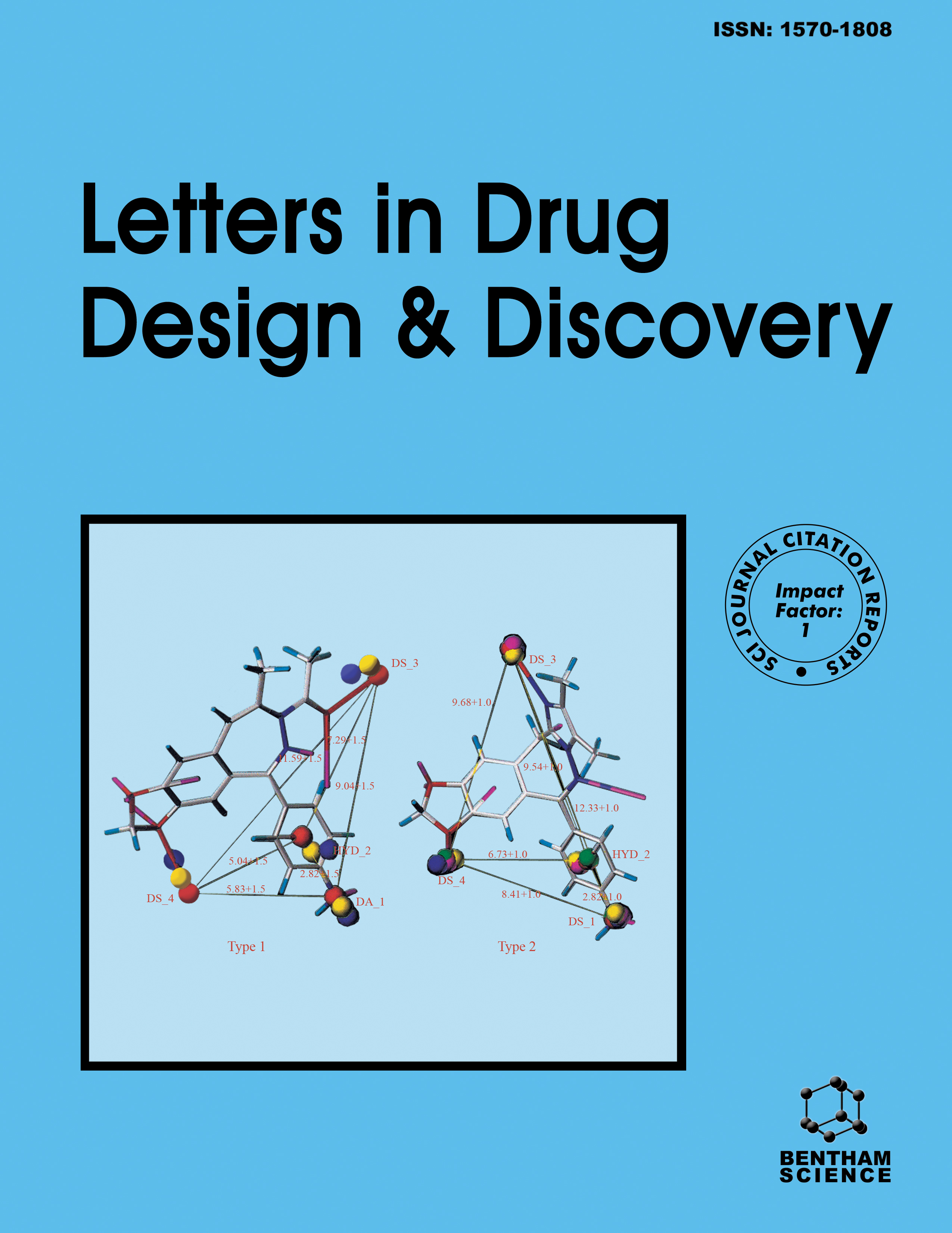- Home
- A-Z Publications
- Letters in Drug Design & Discovery
- Previous Issues
- Volume 12, Issue 2, 2015
Letters in Drug Design & Discovery - Volume 12, Issue 2, 2015
Volume 12, Issue 2, 2015
-
-
Investigation of New Phenothiazine and Carbazole Derivatives as Potential Inhibitors of Human Farnesyltransferase
More LessAuthors: Gina-Mirabela Dumitriu, Alina Ghinet, Dalila Belei, Benoit Rigo, Philippe Gautret, Joelle Dubois and Elena BicuA new series of phenothiazine and carbazole derivatives was synthesized and evaluated for their biological activity on human protein farnesyltransferase. The farnesyltransferase assays revealed that carbazole 4f was the best farnesyltransferase inhibitor in the current study (IC50 (human FTase) = 35.0 μM), providing that the presence of the carbazole unit is important in this family of compounds. Moreover, unexpe Read More
-
-
-
Quantum-chemical Study on the Thermodynamical Aspect of Competitive Inhibition of Ribonucleotide Reductase by trans-Resveratrol, trans- Piceatannol and Hydroxyurea
More LessAuthors: Krzysztof Eder, Damian Mikulski and Marcin MolskiRibonucleotide reductase is an enzyme that catalyzes the formation of deoxyribonucleotides from ribonucleotides. We present for the first time a quantum-chemical study of the thermodynamics of reactions of naturally occurring potent inhibitors (trans-resveratrol, trans-piceatannol and hydroxyurea) of ribonucleotide reductase with tyrosine radical and cysteine radical, scavenging of which is crucial for the inhibition of th Read More
-
-
-
Mannich Base Derivatives as the Potential Candidates of Human Topoisomerase II Inhibitors
More LessAuthors: Huseyin Istanbullu, Muge Senarisoy, Ercin Erciyas and Zeki TopcuMannich bases are pharmacologically important molecules having wide range of bioactivities. We previously synthesized and characterized a number of Mannich base derivatives of planar polycyclic/heterocyclic starting materials of which four of them [MB1 (3-(bis(2-chloroethyl)amino)-1-phenylpropan-1-one hydrochloride), MB2 (3-(bis(2- chloroethyl)amino)-1-(naphthalen-2-yl)propan-1-one hydrochloride), MB3 (3-(bis(2-ch Read More
-
-
-
Pd/C-catalyzed Synthesis of (E)-2-arylmethylideneindolin-3-ols Under Ultrasound: Their Initial Evaluation as Potential Anti-proliferative Agents
More Less(E)-2-Arylmethylideneindolin-3-ol derivatives have been explored as new and potential anti-proliferative agents. Synthesis of these compounds was carried out by using a Pd/C-catalyzed alternative and one-pot method involving C-C coupling of 1-(2-(p-tosylamino)phenyl)prop-2-yn-1-ol with a range of iodoarenes followed by intramolecular hydroamination in the same pot. The reaction proceeded faster when performed under Read More
-
-
-
Synthesis, in Vitro and in Vivo Anticancer Activity of Hybrids of 3- Hydroxy-indolin-2-one and 2,3-Dihydroquinolin-4(1H)-one
More LessAuthors: Lei Zhang, Jing Wang, Wen-Yun Li, Juan Xia, Jing Gao and Qi-Zheng YaoA series of hybrids of 3-hydroxy-indolin-2-one and 2,3-dihydroquinolin-4(1H) -one were synthesized and their anti-proliferative activities against two human cancer cell lines were initially evaluated. Compound 7g was selected for further study and demonstrated moderate anti-proliferative activities against four human cancer cell lines. Meanwhile, 7g had inhibitory effects on the growth of SGC-7901 cells in dosage-and time- Read More
-
-
-
A Divide-and-Conquer Strategy for the Prediction of Protein Contact Map
More LessThe prediction of contact maps in protein is a challenging topic for the determination of three-dimensional protein structures. In this paper, we introduce Forest of Decision Trees, a methodology for the prediction of protein contact maps based on (1) a divide-and-conquer approach to analyze the prediction problem; (2) a codification vector that combines the information obtained from the target amino acids neighborh Read More
-
-
-
4-Substituted-2-Methoxyphenol: Suitable Building Block to Prepare New Bioactive Natural-like Hydroxylated Biphenyls
More LessA small collection of eugenol- and curcumin-analog hydroxylated biphenyls was prepared by straightforward methods starting from natural 4-substituted-2-methoxyphenols and their antitumoral activity was evaluated in vitro. Two curcumin-biphenyl derivatives showed interesting growth inhibitory activities on different malignant melanoma cell lines with IC50 ranging from 13 to 1 μM. Preliminary molecular modeling studie Read More
-
-
-
Alzheimer's Disease Prevention and Use of Traditional Plant Medicines
More LessAuthors: Xiaogang Wang, Raphael Dubois and James David Adams JrSeveral plant medicines are presented that have not been previously discussed in detail and are used in China and the USA for the management of Alzheimer’s disease. These plant medicines may provide new leads for drug therapy of this disease. Prevention of Alzheimer’s disease is presented as potentially the best way to manage the disease.
-
-
-
Synthesis, Characterization and Microbial Activity of New Bisphenol-C Derivatives
More LessAuthors: Bhavin Babu Dhaduk, Chirag Bhupendra Patel and Parsotam Hari ParsaniaA series of bisphenol-C derivatives was synthesized by condensing bisphenol-C with benzylchloride, alkylchloroacetates and alkylchloroformates in the presence of anhyd. K2CO3 in THF using catalytic amount of PEG-600. The compounds were characterized by FTIR, 1HNMR, 13CNMR and MS; and assayed for their antibacterial activity against S. aureus MTCC-96, B. subtilis MTCC-441, E. coli MTCC-443, S. typhi MTCC-98 and antif Read More
-
-
-
Non-Classical Therapeutic Approach in the Treatment of Alzheimers Disease: A Mini Review
More LessAlzheimer's disease (AD) is a multi factorial disease, related to the loss of neurons and synapses in cerebral cortex and subcortical structures, leading to degenerative changes and atrophy. Despite abundance of facts related to AD and its pathology, the only drugs used in the prevention and treatment are those from the cholinesterase inhibitors group. However, there is growing evidence that a non-classical therapeutic a Read More
-
Volumes & issues
-
Volume 21 (2024)
-
Volume 20 (2023)
-
Volume 19 (2022)
-
Volume 18 (2021)
-
Volume 17 (2020)
-
Volume 16 (2019)
-
Volume 15 (2018)
-
Volume 14 (2017)
-
Volume 13 (2016)
-
Volume 12 (2015)
-
Volume 11 (2014)
-
Volume 10 (2013)
-
Volume 9 (2012)
-
Volume 8 (2011)
-
Volume 7 (2010)
-
Volume 6 (2009)
-
Volume 5 (2008)
-
Volume 4 (2007)
-
Volume 3 (2006)
-
Volume 2 (2005)
-
Volume 1 (2004)
Most Read This Month
Article
content/journals/lddd
Journal
10
5
false
en


